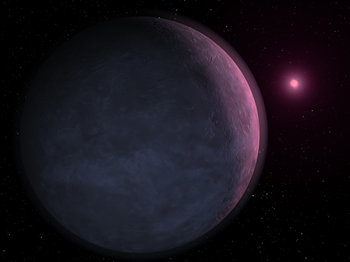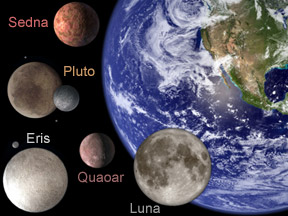Click on image for full size
NASA's Exoplanet Exploration Program
Small Planet, Small Star
News story originally written on June 2, 2008
If there are other planets in the Universe that are like Earth, then they might be places where life could survive. However, the search for planets like Earth is not easy. Most of the planets found outside of our solar system are not like Earth because they are huge - much more massive than Earth.
But now astronomers searching the Universe through telescopes have discovered a small planet about 3000 light years away. Itís the smallest planet ever found that is orbiting a normal star - only three times more massive than Earth.
The star that it orbits is not large. It is perhaps one-twentieth the mass of our Sun. Finding a small planet orbiting a small star suggests that small stars may be good places to look for other small planets.
The small star might, like our Sun, be massive enough to have nuclear reactions in its core. Or it may not have enough mass for the nuclear reactions and instead be an object called a brown dwarf.
The first measurements of the new planet and its star were made by astronomers in New Zealand and then researchers in Chile made more observations. Scientists around the world examined the data.
To find a small planet, the astronomers needed a special way of searching the skies. They used a method called gravitational microlensing, which can find planets as small as one-tenth the mass of Earth. The technique, relies on Einsteinís idea from his General Theory of Relativity that the gravity of a star acts like a giant magnifying glass making a little planet orbiting the star appear larger through the astronomerís telescopes.
Michael Briley, astronomer with the National Science Foundation, says that the discovery of this small planet "is another important step in the search for terrestrial planets in the habitable zones of other stars."















